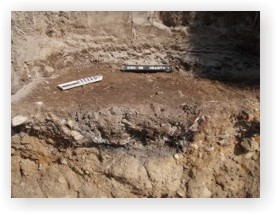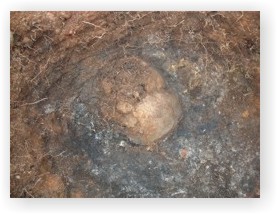Low Hauxley
 |
 |
 |
Low Hauxley is situated at the northern end of Druridge Bay in Northumberland. This particular stretch of coastline is experiencing erosion due to climate change which has caused sea levels to rise rapidly. The sand dunes and cliffs that line the coast are receding which has in turn had a negative impact on coastal archaeology in the area. ARS Ltd. as part of a Rapid Coastal Zone Assessment for English Heritage has identified a number of the most vulnerable sites in North-East England of which Low Hauxley is one of the most important.
In June 2009 ARS Ltd. were alerted by Jim Nesbitt, an amateur archaeologist, of remains eroding from this area. A site visit confirmed that a small stone lined burial box containing cremated human bone was eroding from the cliff face close to where an earlier stone-lined cist burial had been discovered. By the time archaeologists arrived on the site, rising tides had already removed some of the stones from the front of the burial box. It appeared as a stone built box in the cliff face and was at risk of complete destruction. Once excavated, the small cist box was found to contain fragments of human bone as well as a layer of cremation debris at its base. Analysis of the bone fragments have proved them to be mostly from a skull with some long bone also present, although it could not be determined which long bone this was. Due to the fragile nature of the bone the sex of the idividual could not be obtained however we know that they were adult. The white colour of the bone indicates that it had been burned during the cremation at a temperature of around 600ºc. Radio carbon dates on this burial are awaited.
A second cremation found in a pit approximately 10m further south of the cist had also been subject to erosion in the cliff face. It appeared in section and, when excavated, was found to contain two very distinct fills. The lower of these fills contained a number of burnt human bone fragments as well as the remains of a broken pottery vessel. Both features were carefully excavated, photographed, drawn and recorded and the finds were carefully packaged to avoid damage. The finds recovered included: the broken vessel, a number of flint chips and tools and a scattering of limpet shells that were found on the cairn that overlay the small cist box. The bone fragments from the second burial were identified as containing four fragments of femur, two fragments of pelvis, the right mastoid process from a skull and a tooth. The individual is thought to have been an adult male. This cremation was also burned at a temperature of around 600ºc. Radio carbon dates on this burial are awaited.
This site is important as it has the potential to shed light on early Bronze Age occupation in the coastal area of Northumberland. Coastal erosion is having a considerable impact along many areas of the North East coast and we are keen to monitor this erosion. The high quality of the archaeology found at Low Hauxley, along with the damage that it had already sustained, highlights the impact that coastline erosion is having on such sites. The isolated nature of the site and the rapid rate of erosion means that constant monitoring is difficult. Therefore the role of the public is vital in bringing any potential archaeology to the attention of ARS Ltd. to ensure that it can be removed and recorded as quickly as possible.
Northumberland Wildlife Trust have a nature reserve very near to the excavation site at Low Hauxley. Erosion and sea level change are not only major threats to coastal archaeology but also to the various forms of wildlife that inhabit the coastline. To find out more visit Northumberland Wildlife Trust's website by clicking here.
